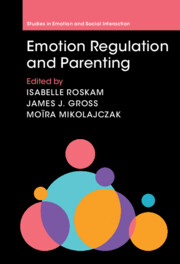Book contents
- Emotion Regulation and Parenting
- Studies in Emotion and Social Interaction
- Emotion Regulation and Parenting
- Copyright page
- Contents
- Figures
- Tables
- Contributors
- Preface
- Part I Conceptual Foundations
- Part II Influence of Parents’ Emotion Regulation on Parenting
- Part III Influence of Parenting on Child Emotion Regulation
- Part IV Current Trends
- Chapter 10 Culture and the Challenges of Being a Good Parent
- Chapter 11 Leveraging Parent–Youth Interactions to Measure and Analyze Emotion Regulation
- Chapter 12 Neurobiology of Parenting and Implications for Emotion Regulation
- Chapter 13 Emotional Labor in Parenting
- Chapter 14 Enhancing Parental Emotion Regulation Skills
- Conclusions and Perspectives
- Index
- Studies in Emotion and Social Interaction
- References
Chapter 11 - Leveraging Parent–Youth Interactions to Measure and Analyze Emotion Regulation
from Part IV - Current Trends
Published online by Cambridge University Press: 05 January 2024
- Emotion Regulation and Parenting
- Studies in Emotion and Social Interaction
- Emotion Regulation and Parenting
- Copyright page
- Contents
- Figures
- Tables
- Contributors
- Preface
- Part I Conceptual Foundations
- Part II Influence of Parents’ Emotion Regulation on Parenting
- Part III Influence of Parenting on Child Emotion Regulation
- Part IV Current Trends
- Chapter 10 Culture and the Challenges of Being a Good Parent
- Chapter 11 Leveraging Parent–Youth Interactions to Measure and Analyze Emotion Regulation
- Chapter 12 Neurobiology of Parenting and Implications for Emotion Regulation
- Chapter 13 Emotional Labor in Parenting
- Chapter 14 Enhancing Parental Emotion Regulation Skills
- Conclusions and Perspectives
- Index
- Studies in Emotion and Social Interaction
- References
Summary
Developmental theories propose that children learn emotion regulation through dynamic interactions with their parents over time. Emotion regulation is transmitted intergenerationally through environmental and genetic pathways, yet both parents and children evoke regulatory capacities from each other. Further, these interactive effects iterate on a micro -level day by day, as well as on a longer time scale, influenced by factors like parenting style and dyadic conflict. Thus, dyadic parent–child emotion regulation is a bidirectional developmental process requiring careful study design, measurement, and analysis. Yet there are fewer research studies on these dynamic processes than one would expect, perhaps due to the aforementioned complexity. In this chapter, we provide a brief theoretical background on interactive emotion regulation between parent–child dyads, review example studies that have addressed these processes, identify conceptual and methodological barriers to conducting this research, and provide resources for researchers. Finally, we highlight the Actor–Partner Interdependence Model to derive interactive and bidirectional inferences into parent–youth emotion regulation.
Keywords
- Type
- Chapter
- Information
- Emotion Regulation and Parenting , pp. 205 - 228Publisher: Cambridge University PressPrint publication year: 2023



